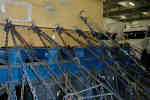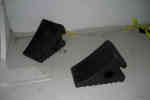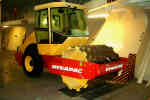Step 2 of 4•5 minutes read
Portable Securing Equipment
Different types of cargo securing equipment are intended for different types of cargo. Sometimes, the most efficient way of achieving a proper cargo securing arrangement is to combine different types, for example, lashings with rubber mats, corner protectors, chocks or trestles.
Great care should, however, be taken when combining lashing equipment of different strengths, materials or lengths in the same cargo securing arrangement since the force will then be very unevenly distributed among the lashings.
Web Lashing
Web lashings are made from synthetic fibres and are normally equipped with hooks at both ends. A ratchet is used to produce the required tension. A typical length for web lashings is approximately 10 meters, and they normally have an MSL of about 2 tons (20 kN). The lashing should be tightened as much as possible before applying the tensioning device. Web lashings are commonly used to secure cargo in or on cargo transport units, such as trailers, containers, or container flats. Web lashings are to be protected from sharp edges by using, for example, corner protectors or rubber mats.

Web lashings are made from synthetic fibers
Roll Lash
Roll lash is a strong web lashing that is designed for securing RoRo cargoes such as trailers, roll trailers, or vehicles. Roll lash equipment may have hooks, elephant foot hooks, or slings attached to their ends. This type of equipment is sometimes also called truck lashing or trailer lashing. The MSL of roll lash equipment is normally between 5 and 6 tons, and the typical length is 3 meters. The lashing should be tightened by hand as much as possible before it gets tightened by the ratchet. If the sling is to be applied around some part of the cargo unit, it has to be protected from sharp edges by using, for example, corner protectors or rubber mats.

Roll lash is sometimes called truck lashing or trailer lashing
Car Lashing
Car lashings are web lashings that are intended for securing cars, vans or other light vehicles. They typically have an MSL of 1 ton (10 kN). To minimise the risk of damage to the vehicles, the car lashing hooks are covered with rubber. When both hooks have been attached to the appropriate securing points, the lashing should be tightened by pulling the loose end. When done, the handle shall be closed.

Car lashings are provided with rubber details and are designed for securing cars and light vehicles
Chain Lashing
For heavy cargoes such as vehicles, machinery, project cargoes, and steel products, chain lashings are commonly used. Chains are fitted with either hooks or elephant feet. When the chain has been attached to the lashing points, a tensioning lever or a turnbuckle is used to produce the required tension. Sometimes, extension handles are applied to the tensioning lever to increase the pre-tension produced in the lashing.

Chain lashings to secure cargo to a roll trailer

Chain lashings to secure cargo directly to the vessels deck
Slings
For vehicles not equipped with appropriate lashing points, slings may be used, typically by attaching them to the rims of the wheels.

Chain lashings attached via slings to a vehicle axle

Car lashings attached via a sling to the rim of the wheel of the vehicle
Corner Protectors
To avoid cargo damage caused by the securing equipment, corner protectors may be used to distribute the pressure over a wider area. The use of corner protectors may also prevent lashings from being damaged by sharp edges.

Corner protectors are made to protect cargo, but also to protect lashings from sharp edges
Chocks
To prevent vehicles from rolling, chocks of varying sizes may be used. They should preferably be placed under the vehicle's unbraked axle. The use of chocks is confined to vehicles stowed athwartships (across the ship, from side to side) or in sloping ramps.

Chocks are used to prevent vehicles from rolling
Rubber Mats
To increase the friction between the cargo and the deck of the vessel, rubber mats may be used. Rubber or wooden dunnage should always be used to avoid steel-to-steel contact surfaces. Furthermore, for cargo and other equipment sensitive to damage by the securing arrangement, rubber mats or felt pads can be placed between the cargo and the lashings.

Rubber mats increases the friction between materials
Jacks
Rolltrailers and similar units are very sensitive to tipping since they tip around the center of each boogie and not the outer edge of the wheels. To increase the stability width and thereby prevent roll trailers and other vehicles from tipping over, jacks may be placed underneath the supporting side beams.

Jack (blue in the picture) used on a roll trailer in order to increase the support width